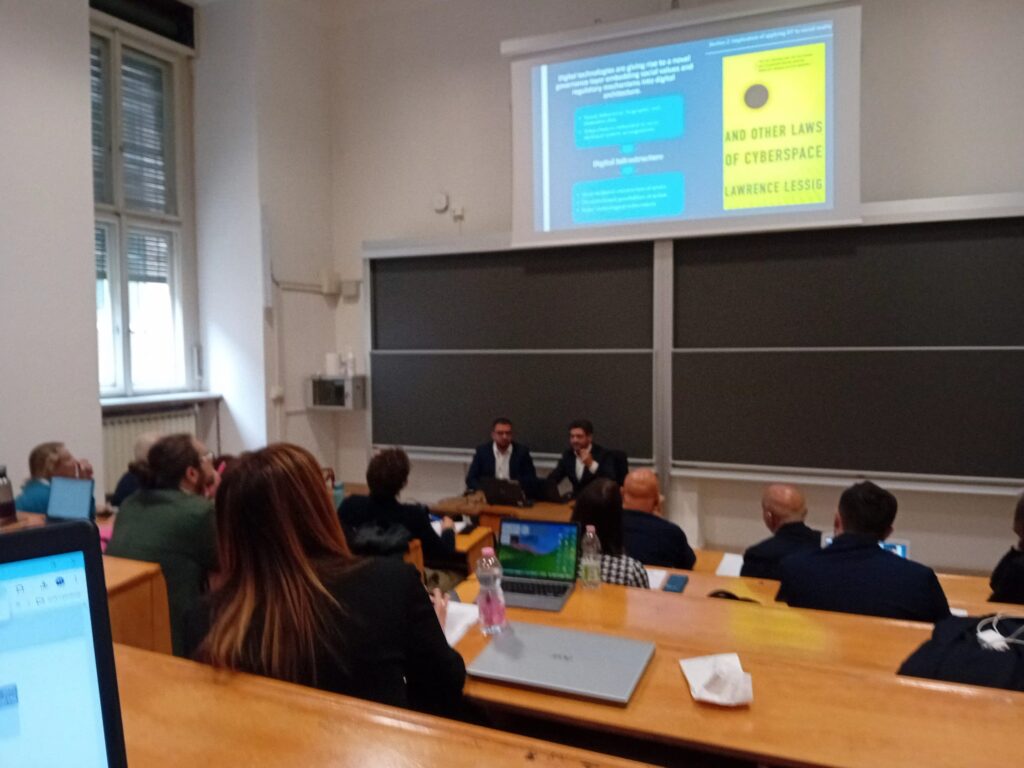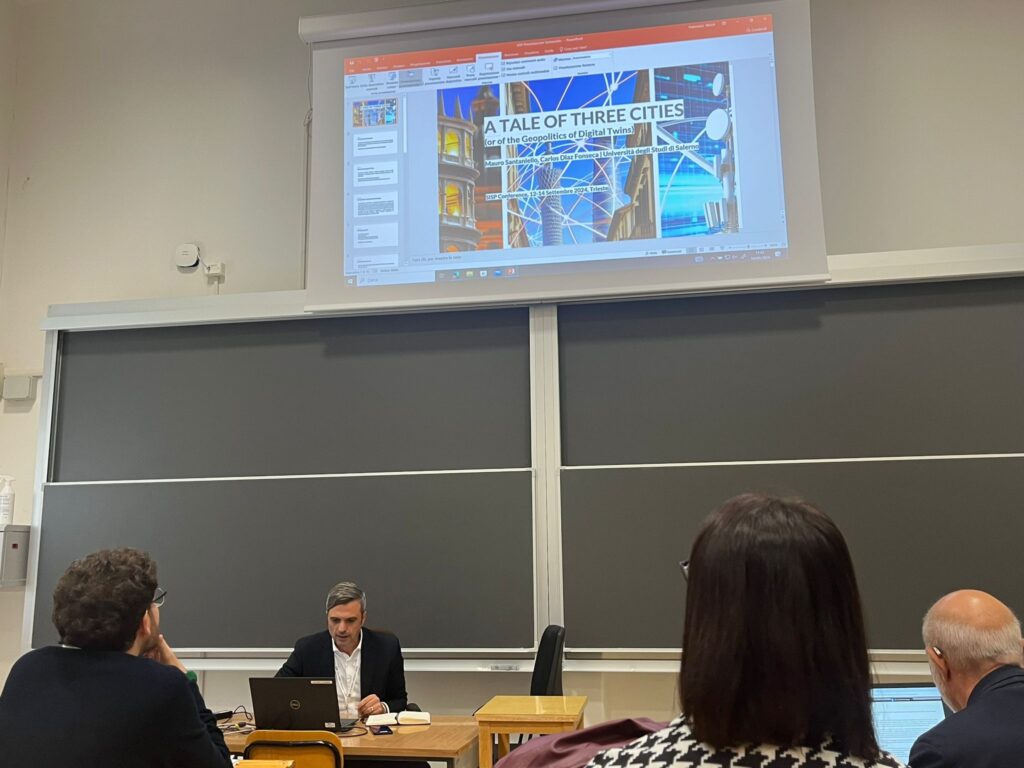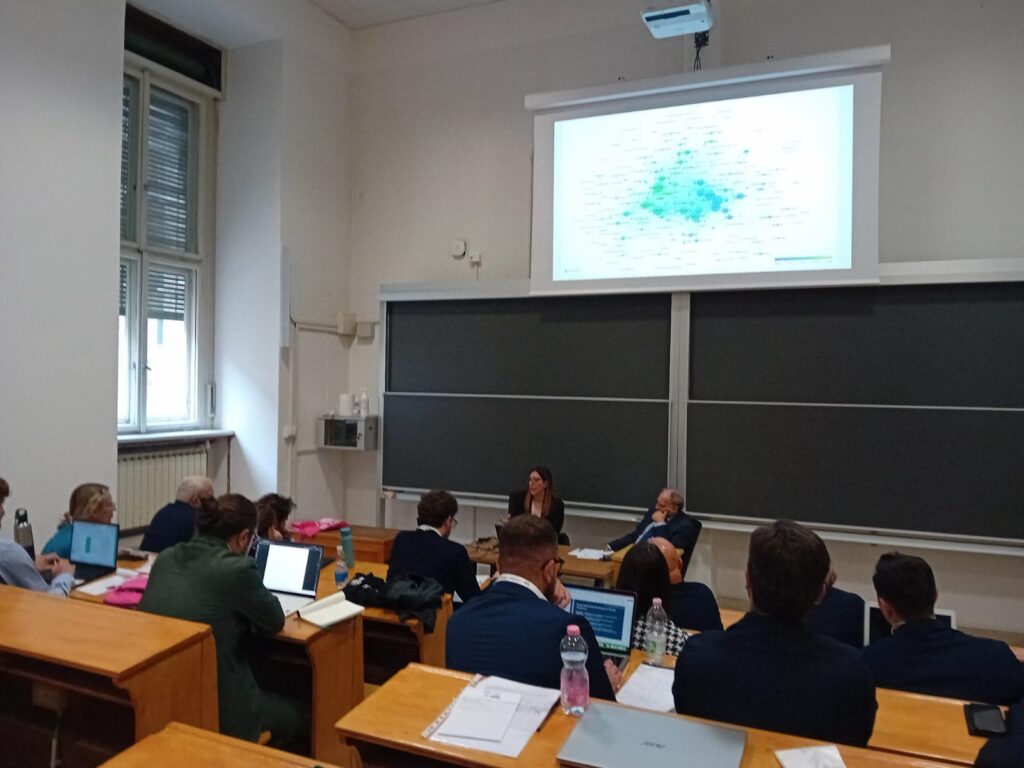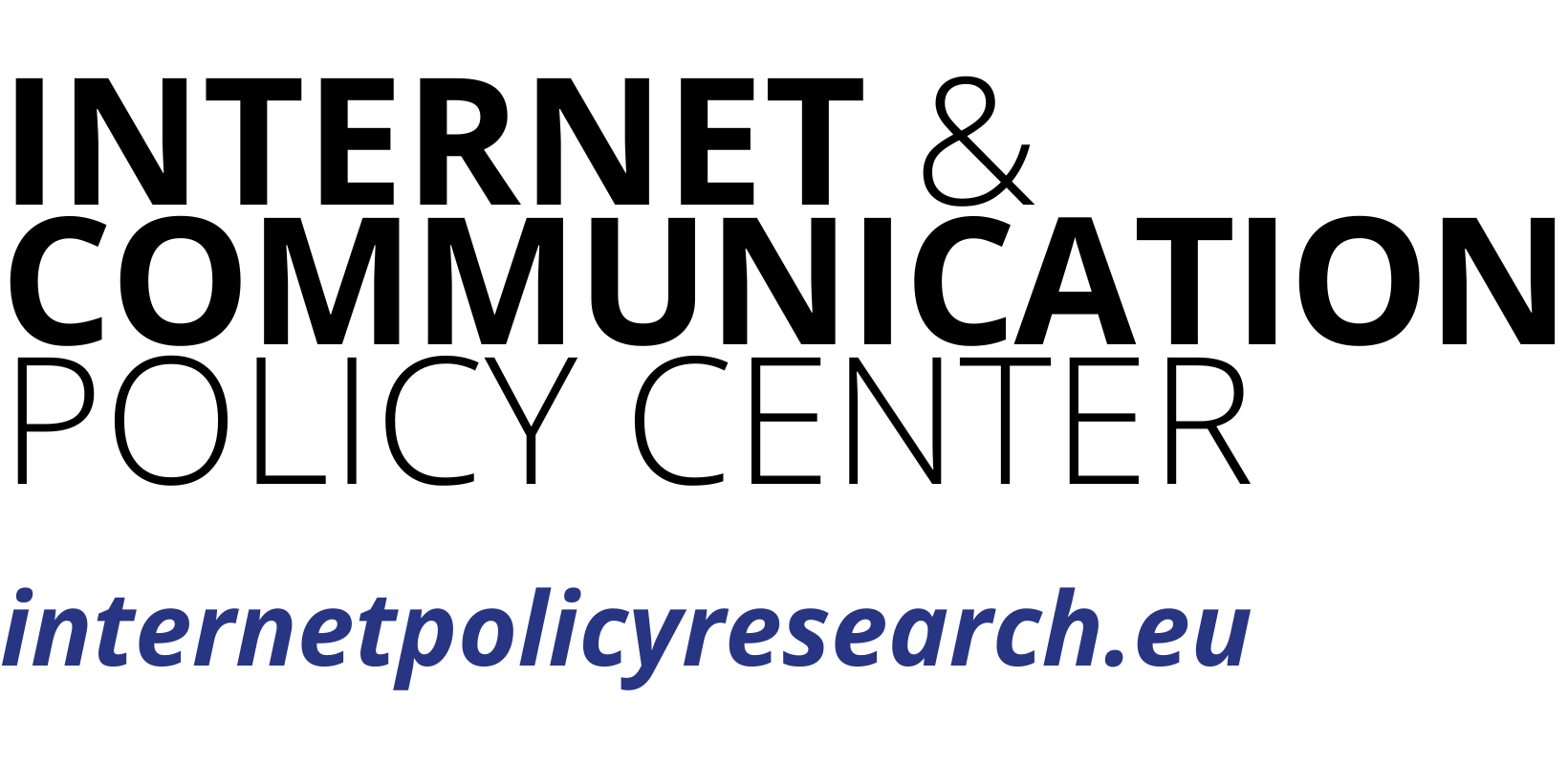ICPC Researchers Attend the 37th SISP Conference at Università di Trieste

Researchers of the Internet and Communication Policy Center (ICPC) attended the 37th Annual Conference of the Italian Political Science Association (Società Italiana di Scienza Politica, SISP), which was held at the Università di Trieste from September 12 to 14, 2024.
ICPC members Mauro Santaniello, Francesco Amoretti, Nicola Palladino, Serena Fraiese, and Gerardo Ferrentino participated in the panel discussion, “The Politics and Policy of Digital Twins.” Their contributions highlighted the diverse applications of digital twin technologies across geopolitical, social, and governance contexts.


We look forward to continued collaboration in the field of digital policy and technology. Below, you can find the detailed abstracts of each presented paper.
Mauro Santaniello presented the paper The Geopolitics of Digital Twins (A Tale of Three Cities), co-authored with Carlos Fonseca.
Abstract: By creating real-time, data-driven models of physical objects, systems, or processes, digital twins enable new economic, societal and political interactions. Since the design and the deployment of digital twins is still in its infancy, there is a lack of shared definitions, common standards and empirical data about their use and their political implications. However, it is widely recognized that the rise of digital twins is not merely a technological advancement but a paradigm shift in human-network interaction, with profound political consequences. While there is a discrete literature that addresses possible political implications of digital twins, there is still a lack of studies about the processes of political shaping of technology which explores how digital twins are shaped by power dynamics and strategic competition. This paper seeks to partially fill this gap by answering the following research questions: what technologies are constitutive of digital twins, and who controls them? The paper first outlines and contextualizes the rise of the Digital Twin (DT) from theoretical, historical, and political perspectives.Then, it presents a conceptualization of the digital twin as a socio-technical assemblage of different technologies, including sensors, robotics, data management systems, artificial intelligence, telecommunications, cloud and digital certifications. For each one of these components, a technopolitical analysis is conducted through the use of a heterogeneous set of secondary data, in order to assess the level of power concentration in each technological sector that is constituent of the DT. Findings are finally discussed from a geopolitical perspective, which emphasizes some important aspects related to authority and control of the DT in democratic societies.
Serena Fraiese and Francesco Amoretti presented the paper titled Digital Twins Technologies in Morocco, co-authored with Abdessamad Rhalimi (University Euromed of Fez).
Abstract:
The digital technologies, particularly AI, machine learning, and more recently Digital Twins, are rapidly advancing across the globe, putting new challenges to decision makers as well as to scientific communities. These technological innovations seem to possess broad and, in some ways, as yet unexplored transformative potential – opportunities – but also serious risks for the lives of individuals and for social systems and communities. The specialist literature has dwelt on the significance and implications of these transformations, considering above all the experiences of Western democracies or non-democratic regimes, such as China and Russia, which openly challenge the West on the terrain of technological innovation, threatening its supremacy. Other geopolitical areas and other experiences, no less significant than those just mentioned, have instead remained in the shadows or completely ignored, especially the Middle East and North Africa. To begin bridging this gap, the proposed study aims to explore how Digital Twin technologies are defined, perceived, and implemented in the MENA region, with particular focus on Morocco. This choice is justified by Morocco’s proactive attitude in digital transformation (Ouajdouni et al. 2020; Mezzour et al., 2020; Khalil Ibrahim & Benabdelhadi, 2021) and strategic initiatives in modernizing public administration and urban infrastructure (Hilali & El-Yousfi, 2023). Furthermore, its geographical location between Africa, Europe and the Middle East, offers Morocco opportunities for strategic partnership, investment and trade, strengthening the Kingdom’s ambition to become a digital hub in the region (Ben Dahhane et al. 2023; ElHazziti et al. 2023; Soulé, 2023).
The main objective of the paper is to offer a mapping of the main areas of application of the Digital Twin, highlighting the prevailing interpretative frames, the discursive structures adopted, and the nature and orientations of the actors involved. The hypothesis is that the deployment of Digital Twin technologies in Morocco is not only influenced by the technological and administrative priorities, but it is also influenced and shaped by the country’s constitutional culture, with the monarchy playing a key role in integrating religious and traditional dimensions. This dualism presupposes that digital innovations are not purely means to enhance public administration, urban infrastructure, industry, educational, social and health programs; but they are also instruments to reinforce the legitimacy and accountability of the political and institutional system, blending digital transformation technology and traditional religious values (Naguib, 2019). To enhance the theoretical knowledge and understanding on both the Digital Twin deployment in the region, and the role of the cultural tradition and religion in influencing the digital transformation in the country, the study will employ a mixed methodological approach, combining an extensive literature review, as well as semantic and textual analysis. First, it is paramount to collect a corpus of texts ranging from academic papers, policy documents, royal decrees, laws and government reports related to Digital Twins technologies in Morocco. The review will explore Digital Twin definitions and frameworks, explain how different countries and sectors are adopting this technology, and highlight the opportunities (i.e. decision-making, real-time management, public service delivery) and challenges (i.e. data privacy, intellectual property, governance) acknowledged within the Moroccan context. Next, a semantic and textual analysis will be carried out, using a Natural Language Processing tool, to both identify and classify key themes, trends, and terminologies associated with Digital Twins discourse, and to examine the (perceived) benefits, the risks, and the socio-political impacts.
Nicola Palladino and Gerardo Ferrentino presented the paper Digital Twins in Border Control and Migration Policies: Balancing Security and Human Rights for Sustainable Governance, co-authored with Yasha Maccanico.
Abstract: The Digital Twin (DT) is a transformative technology supporting digital transformation and decision-making across various sectors. Conceptualized by Michael Grieves in 2002[1], the DT consists of three core components: a physical product in the real space, a virtual representation in the virtual space, and the data and information connections between them. This model enables real-time data exchange and synchronization, making the DT more than a static model; it is a dynamic, intelligent, and evolving entity that mirrors its physical counterpart. Grieves and Vickers[2] later formalized the DT model, distinguishing between Digital Twin Prototype (DTP) and Digital Twin Instance (DTI), which operate within a Digital Twin Environment (DTE). The DTP represents a prototype physical artifact and includes requirements, annotated 3D models, bills of materials, and production processes. The DTI describes a
specific physical product, linked to it throughout its life-cycle, and includes data such as annotated 3D models, component histories, production processes, service records, and sensor-based operational states. The DTE is an integrated space for DT operations, supporting predictive analysis to ensure designs meet proposed requirements within tolerance variations. Thus, a DT can be defined as “a virtual representation of a physical system (and its associated environment and processes) that is updated through the exchange of information between the physical and virtual systems.”[3] This continuous interaction allows for monitoring, control, and optimization of processes, enabling predictive maintenance and innovative configurations. In this paper, we argue that moving from physical to social reality, DT could be conceived as a map or a tool to design and test governance architectures which are also implemented for the most part through digital technologies. Given that digital architectures, explicitly or not, embed social values and norms[4], the way in which DTs are built, the goals and purpose for which they are established, and the data that are selected to represent the reality they refer to may result in a form of digital governamentality capable of shaping actors’ subjectivity, disciplining their conduct and treatment[5]. In particular, in this work, we will focus on the use of digital technologies (datasets, facial recognition, artificial intelligence, platforms) in border control and migration policies as they are deployed in the EU’s Justice and Home Affairs policy field. Endeavours in this policy field increasingly rely on information systems[6], on interoperability between migration and law enforcement databases, on automated access systems[7], on watchlists, and surveillance technologies[8] in order to improve the “situational picture” available to authorities as an evidence base for further interventions. To do so, the paper explores existing and prospective links between systems that are currently in use or whose development is underway,
and the prospective use of DT models for the development of AI solutions in the migration and asylum field, including for screening and automated decision-making. The analysis points out that, in line with current practices, the development of DTs may result in further securitization of the migration issue,
criminalization of migrants, and a scaling up of systematic power abuses, human rights violations, and rule of law infringements. The development of algorithms may lead to “risk indicators” being used to justify outcomes resulting in exclusion (from the EU’s territory and/or from asylum proceedings) at the same time as expansive data collection practices, particularly by EU agencies like Frontex and Europol, may undermine key data protection principles[9]. Finally, the paper will discuss how Digital Twins (DT) technology can be designed using a non-securitarian approach to improve the efficiency of immigration reception processes. This approach aims to shift away from an emergency logic, thereby preventing the eruption of social tensions. We will propose specific recommendations to achieve this goal, including the integration of predictive analytics and virtual simulations to optimize resource allocation, estimate migrants’ needs, and identify the most likely patterns and sites for successful integration, as well as the implementation of transparent data-sharing practices to enhance collaboration among stakeholders while
respecting international human rights standards. These strategies will not only facilitate a more humane and sustainable management of immigration but also promote social cohesion and resilience within host communities.



Comments are closed, but trackbacks and pingbacks are open.